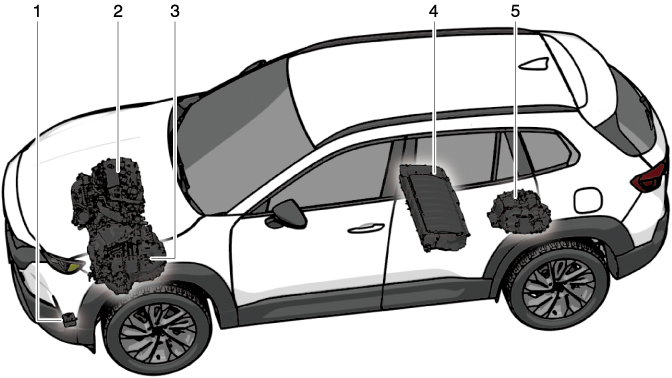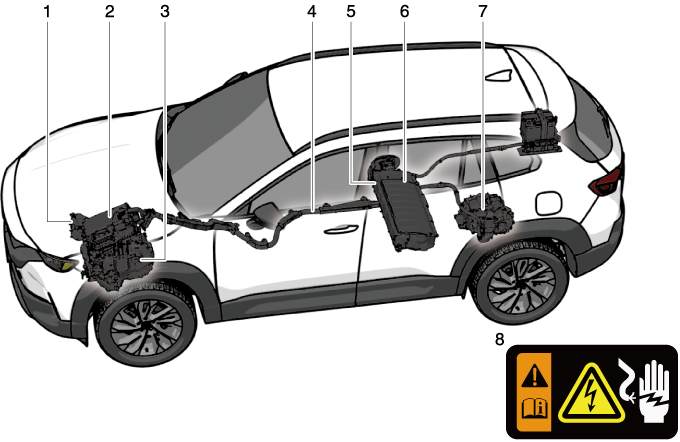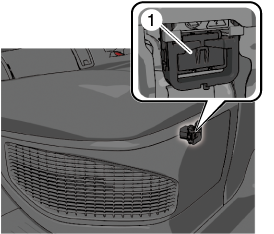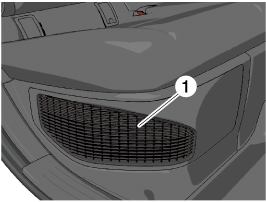Hybrid System
Hybrid System
Because hybrid vehicles have different features from conventional vehicles, operate the vehicle with care and with a full understanding of the vehicle’s features. Hybrid vehicles use a combination of an engine and a motor depending on the driving conditions to improve fuel efficiency and reduce exhaust emissions.
-
The high-voltage components and cables of hybrid vehicles are electromagnetically shielded, therefore they generate electromagnetic waves comparable to those generated by conventional vehicles and home appliances.
-
In some amateur radio systems (long-distance communication), noise may occur during reception.
Hybrid System Overview

-
Approaching vehicle audible system
-
Engine
-
Front motor
-
High voltage battery
-
Rear motor
Engine
Engine power is used during normal driving and acceleration. The engine stops when stopping, accelerating from a stop, driving at low speed, or driving downhill.
-
The engine starts or stops automatically. The engine may not stop automatically under the following conditions.
-
The engine is warming up.
-
The high voltage battery is charging.
-
The high voltage battery temperature is high or low.
-
The heating is being used.
-
-
If the lead-acid battery terminals were disconnected due to a dead lead-acid battery or a lead-acid battery replacement, the engine may not stop even when the vehicle is running on the high voltage battery. If this condition continues for 2 to 3 days, contact an Authorized Mazda Dealer.
Front motor/Rear motor
The front motor/rear motor power is used when accelerating from a stop, driving at low speeds, or driving downhill. When the vehicle is driven only by the front motor/rear motor, the EV indication  in the instrument cluster turns on. The front motor/rear motor is used to assist the engine during normal driving and acceleration. When braking, the motor is used to decelerate the vehicle and the motor is used as a generator to charge the high voltage battery.
in the instrument cluster turns on. The front motor/rear motor is used to assist the engine during normal driving and acceleration. When braking, the motor is used to decelerate the vehicle and the motor is used as a generator to charge the high voltage battery.
Regenerative braking
Regenerative braking uses the motor to decelerate the vehicle. Power is generated by the wheels rotating the motor while decelerating and the generated power is stored in the high voltage battery.
When the gasoline particulate filter is removing particulate matter (PM), it may not be possible to charge the high voltage battery.
High voltage battery
The electric power generated by the regenerative braking is stored in the high voltage battery. This eliminates the need for charging from outside the vehicle.
-
The vehicle should be driven for about 30 minutes or 16 km (10 miles) every 2 to 3 months because the high voltage battery gradually discharges itself when the vehicle is left unattended for long periods of time. If the high voltage battery discharges completely and the hybrid system cannot be started, contact an Authorized Mazda Dealer.
-
The high voltage battery life changes depending on the vehicle storage conditions or driving conditions.
Approaching vehicle audible system
The approaching vehicle audible system notifies pedestrians that the vehicle is approaching using an audible sound when the vehicle is being driven by the motor only. The notification sound is activated when the vehicle speed is 41 km/h (25 mph) or slower.
-
In the following cases, it may be difficult for surrounding people to hear the notification sound.
-
The surrounding noise level is high.
-
In rain or strong winds.
-
-
Because the approaching vehicle audible system is installed at the front of the vehicle, it may be more difficult to hear the notification sound at the rear of the vehicle than at the front.
Warning and Cautions for Using the Hybrid System
The hybrid system has high voltage areas and high temperature areas. Labels indicating the cautions on use are applied to these areas. Always follow the instructions on the label and use the vehicle correctly.
Be very careful of high voltage areas. In addition, do not disassemble, modify, or remove any high voltage parts.
The following areas contain high voltage parts and may cause electrical shock if touched.

-
Electric compressor
-
Power Control Unit
-
Front motor
-
High voltage cable
-
Service plug
-
High voltage battery
-
Rear motor
-
Warning label example
Be very careful of high temperature areas.
The hybrid system and the engine become hot when they operate. Follow the instructions on the label attached to the vehicle and always pay attention to high voltage areas and high temperature areas.
Do not touch the service plug.
A service plug is installed in the high voltage battery. This service plug is used at an Authorized Mazda Dealer when repairing vehicles in order to cut off the high voltage of the high voltage battery. Do not touch the service plug. If you handle the service plug mistakenly, it could lead to an electrical shock causing serious injury or death.

-
Service plug
Maintenance and Repairs
For vehicle maintenance or repairs, consult an Authorized Mazda Dealer. Technical knowledge and skill are necessary in handling the high voltage battery.
To ensure safe and correct handling of the high voltage battery, always heed the following precautions.
-
Do not remove the high voltage battery.
-
Do not resell, transfer, or modify the high voltage battery.
-
Do not make secondary use of the high voltage battery.
If the high voltage battery is not handled properly, the following may occur which could lead to serious injury or death.
-
Touching an unattended high voltage battery may cause an electric shock.
-
If the high voltage battery is used on a vehicle other than the one it came equipped on (including modified vehicles), accidents such as electric shock, heat generation, smoking, combustion, and explosions, or an electrolyte leakage may occur.
If an Accident Occurs
If the vehicle receives an impact of a certain level or greater in a collision, the hybrid system stops. At this time, the charging system warning light turns on and the hybrid system may not start. Park the vehicle in a safe place immediately and contact an Authorized Mazda Dealer.
Do not continue to drive the vehicle.
To prevent further accidents, stop the vehicle in a safe place, shift the selector lever to the P position, and then apply the parking brake to stop the hybrid system.
Never touch electrical wiring that may be protruding into or outside of the cabin.
Otherwise, it could result in electrical shock and serious injury.
Never touch any area where electrolyte is visible or electrolyte is leaking from the area.
If electrolyte from the high voltage battery gets in the eyes or on the skin, it could cause loss of vision or skin reactions. If electrolyte comes into contact with the eyes, do not rub them, and after flushing with water for 15 minutes or longer, seek medical attention immediately. In addition, if electrolyte comes into contact with the skin, wash the areas with soap and water thoroughly. If you feel any abnormality in your body, seek medical attention immediately.
Never approach objects that are on fire or extremely hot.
Electrolyte in the high voltage battery may cause a fire. If the vehicle catches fire, extinguish the fire using a fire extinguisher (type ABC, BC, or C). Only extinguish a fire with water when a large amount of water is available such as from a fire hydrant. Using a small amount of water may cause the fire to spread.
Do not tow the vehicle with the drive wheels grounded.
Otherwise, the motor generates electricity which may cause a fire depending on the condition of the damage. When towing the vehicle, tow it with all 4 wheels off the ground.
Do not start the hybrid system if there is liquid leaking from the vehicle (other than air conditioner water).
If liquid leakage (other than air conditioner water) is found on the road surface under the vehicle, the fuel system may be damaged. Starting the hybrid system in this condition, may cause a fire. Do not start the hybrid system and contact an Authorized Mazda Dealer.
Scrapping Your Vehicle and Disposing of High Voltage Battery
The high voltage battery is collected to prevent accidents involving it. When scrapping your vehicle, replacing the high voltage battery, or disposing of the high voltage battery, consult an Authorized Mazda Dealer. Please cooperate in ensuring that the vehicle's high voltage battery is collected.
Appropriate disposal of the high voltage battery.
If the high voltage battery is not collected and disposed of appropriately, such as by leaving it unattended or illegally abandoning it, some other person may touch it which could cause electrocution leading to serious injury.
How to Use the Hybrid System
EV Mode
Always confirm the safety around the vehicle before using EV mode.
Because there is no engine sound, pedestrians in the surrounding area may not notice the vehicle departing or approaching.
In EV mode, the vehicle is driven by the motor only using the electrical power stored in the high voltage battery.
-
Start the hybrid system.
-
Press the EV switch.

EV mode operates and the EV mode indication
 turns on.
turns on.Press the EV switch again to cancel EV mode.
-
In the following cases, switching to EV mode may not be possible. When switching to EV mode is not possible, a warning sound is activated and a message is displayed on the multi-information display.
-
The hybrid system temperature is high or low.
-
The engine is warming up.
-
The high voltage battery power is low.
-
The vehicle is driven at a high speed.
-
The accelerator pedal is fully depressed.
-
The vehicle is driven on a slope.
-
The windshield defroster switch is on.
-
-
In the following cases, EV mode is automatically canceled. When EV mode is canceled, a warning sound is activated, the EV mode indicator in the instrument cluster flashes, and a message is displayed on the multi-information display.
-
The high voltage battery power is low.
-
The vehicle is driven at a high speed.
-
The accelerator pedal is fully depressed.
-
The vehicle is driven on a slope.
-
-
The maximum driving distance while in EV mode is about 1 km (0.6 miles) or less.
-
The hybrid system controls the engine and motor to achieve the best fuel economy according to the driving conditions. For this reason, heavy use of EV mode may worsen fuel economy.
Unique sound and vibration occurring with hybrid vehicles
There may be no engine noise or vibration even when the READY indicator light  on the multi-information display is turned on and the vehicle is ready to be driven. For safety purposes when parking the vehicle, shift the selector lever to the P position and apply the parking brake.
on the multi-information display is turned on and the vehicle is ready to be driven. For safety purposes when parking the vehicle, shift the selector lever to the P position and apply the parking brake.
Hybrid vehicles have a unique sound and vibration which differ from non-hybrid vehicles. The following sounds or vibration may occur, however, this is unique to hybrid vehicles and it does not indicate a problem.
-
The motor sound from the engine compartment.
-
The sound from the high voltage battery when starting or stopping the hybrid system.
-
Operation sounds such as click-clacks from the relay when the hybrid system starts or stops.
-
The operation sound when liftgate is opened.
-
The sound from the transmission when the engine is started or stopped, when the vehicle is traveling at low speed, or when idling.
-
The engine sound during sudden acceleration.
-
The sound of the cooling fan from the air intake port under the rear seat.
-
Vibration when starting or stopping the engine.
Air intake port for high voltage battery
There is an air intake port under the rear seat for cooling the high voltage battery.

-
Air intake port
-
Do not block the air intake port with a seat cover, luggage, or carpet. Otherwise, the temperature of the high voltage battery may increase and the high voltage battery may be damaged. Clean the air intake port regularly to prevent clogging.
-
Do not allow water or foreign matter to get in the air intake port. Otherwise, the high voltage battery could be damaged.
How to clean
Do not clean with water or liquids.
If the high voltage battery gets wet, it may cause a malfunction or vehicle fire.
Do not touch the service plug.
There is a service plug near the air intake port. Do not touch the service plug. If you handle the service plug mistakenly, it could lead to an electrical shock causing serious injury or death.
Always switch the vehicle power OFF before cleaning. In addition, do not put a hand or foot into the air intake port.
Becoming caught in the cooling fan or receiving an electrical shock from touching high-voltage areas may result in serious injury or death.
-
Perform cleaning immediately when a message is displayed on the multi-information display. If you continue driving while the message is displayed, the high voltage battery may be damaged.
-
Do not use an air blower for cleaning. Otherwise, dust could be forced in which could decrease the high voltage battery output or damage it.
-
Heed the following instructions to prevent vehicle damage.
-
Do not allow water or foreign matter to get in the air intake port.
-
Always put back the filter and air intake port cover after cleaning.
-
Do not install a filter from another vehicle or anything other than a filter to the air intake port.
-
Do not drive the vehicle with the filter removed.
-
-
Heed the following instructions to prevent filter damage.
-
Do not use an air blower.
-
Do not press a hard object such as a vacuum cleaner against the filter.
-
Do not use hard brushes such as metal brushes.
-
Do not crush the folds in the filter.
-
-
Switch the vehicle power OFF.
-
Use a flathead screwdriver with a clean cloth wrapped around the end to remove the clip.

-
Clip
-
-
Pull the air intake port cover and remove the clips.

-
Clip
-
-
Pull the air intake port cover and remove the air intake port cover while pulling out the hook.

-
Hook
-
-
Remove the filter from the 4 tabs locations on the air intake port cover.

-
Tab
-
-
Remove the tabs on both ends, and remove the filter from the air intake port cover.

-
Tab
-
-
Clean the filter.
-
Install in the reverse order of removal.
After cleaning, you may need to drive the vehicle for about 20 minutes until the message displayed on the multi-information display disappears. If the message does not disappear, have the vehicle inspected by an Authorized Mazda Dealer.
















































